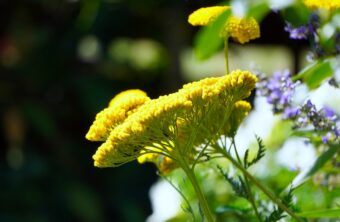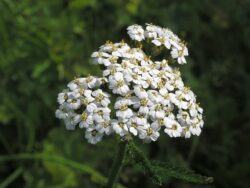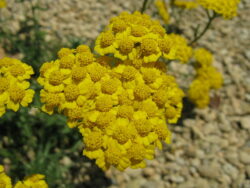In this article, we will discuss how to grow the beautiful foliage and bloom plant of Achilleas in containers. Achilleas or yarrow or Milfoil as it is commonly known, are border perennials that are grown for their feathery foliage and the tiny, flat plated flowers that appear on top of the leaves.

The flowers that are traditionally produced en masse tend to be yellow but they can be white, pink, red or cream. The leaves make a great alternative to other perennials that have broad leaves and so will make a great addition to the container garden.
It is an old favourite that has recently fallen back into fashion due to the plant’s ability to attract wildlife, especially hoverflies.
Let us find out how to grow Achilleas in containers in this article.
GROWING ACHILLEAS IN CONTAINERS
Although, it is common to buy Achillea as garden-ready plants but it is also possible to grow them from seeds.
GROWING FROM SEED
For the best result, you can show seeds in late summer or autumn, where young plants can be overwintered. This is not the only way, as it is also possible to sow seeds in late winter to early spring.
To do this, fill a seed tray with a good quality seed sowing compost and water it well. Until the compost is moist, On top of the surface of the compost, scatter the seeds thinly and evenly over the surface. As the seeds need light to germinate, then it is best to cover the seed with a thin layer of crushed, powdery vermiculite. Place a propagator lid on top of the tray and place it on a warm windowsill. After a week or so, the seed should start to germinate.

Once the seedlings are large enough to handle, prick them out and transplant them into 7.5cm pots full of good quality, multipurpose compost. Allow the young plants to grow on and do not be too keen to throw the palest young seedlings away, as these can produce the best-coloured flowers. You can harden them off before allowing them to grow on in a greenhouse. You can overwinter them in a greenhouse, ready to be planted out in spring the following year.
If you planted in late winter and early spring, you will need to harden off in late spring for planting out in late May.
PLANTING IN CONTAINERS
At this stage, shop-bought Achilleas and home-reared young plants can be treated in exactly the same way.
First, choose a container that is in proportion with the plant in question and will suit the scheme you are going for. No matter what you choose, make sure it has plenty of drainage holes. On top of the bottom of the planter, add a 1cm later of gravel to help with drainage. On top of this, add multipurpose compost until it near reaches the rim.
Dig a hole that is slightly bigger than the root ball it came in the original container. You can add some grit at the bottom of the hole to improve drainage. Drop the plant in so that the top of the root ball is at the same level as the top surface of the compost. Backfill with the growing media, ensuring that no gaps remain. Firm the plant in and water well.

Achilleas do their best if grown in full sun in a free-draining growing media. They absolutely hate for the roots to be waterlogged. Once the perennial is established, it will tolerate drought well but it is best to water when 5cm below the top surface of the compost feels dry to the touch.
LITTLE CARE IS NEEDED
It does not really need much in the way of care but it will need to be fed once a year in early spring with a slow-release fertilizer to give a boost through the growing season. They can be tall plants and so will need to be stalked to prevent them from getting damaged in the wind.
The only other thing, you will have to do is deadhead flowers throughout the summer to encourage more blooms to form. Cut back spent blooms in autumn and old foliage in spring. The leaves will die back in autumn to appear in spring again the following year.
It will need to be divided every 2 to 3 years as it can get congested in the containers and this will give the plant enough room to grow on. Some varieties are short-lived and will die after a few years of producing prolific flowers. These tend to be prolific self-seeder that will produce young plants near the mother plant and is useful if you want to propagate the yarrow. The only problem is that it may not breed true to the original parent plant. This may not be good for those who want a carbon copy.
PESTS AND DISEASES
They tend to be relatively trouble-free but if you are unlucky aphids may be attracted to the plant. To deal with them, blast them with water or use a suitable systemic insecticide. Another problem, especially if it gets dry at the root, is powdery mildew. Water to prevent this and provide air circulation around the centre of the plant. Poor air circulation will not be healthy for the plant.
VARIETIES TO GROW
Two species are recommended to be grown and these are Achillea filipendulina and Achillea millefolium.
Achillea filipendulina is a tall species that can grow up to 1.5m varieties. Varieties to grow is ‘Gold Plate’ that has 15mm wide, yellow flat-topped flowers that appear between June and September. ‘Cloth of Gold’ is similar but more compact.
For more compact varieties, there are hybrids like ‘Coronation Gold’ and ‘Moonshine’ that produces yellow flower heads. ‘Terracotta’ is a variety that produces beautiful orange flowers that fade to yellow with age.

The other species is the more colourful Achillea millefolium, where plenty of named varieties exists. This includes ‘Cerise Queen’ that produces Cerise flowerheads with dark margins and paler toward the centre, ‘Fanal’ produces orange-red flowers with yellow centres, ‘Paprika’ produces red flowers and ‘Lilac Beauty’ produce mauve flowers.
For those who are seeking small dwarf types, there is Achillea tomentosa that grows up to 20cm high and produces 7.5cm wide, yellow flower heads and elegant ferny, green-grey leaves.
For a great alternative that produces white daisy-like flowers is to grow Achillea argentea.
CONCLUSIONS
In this article, we have discussed how to grow Achilleas in containers. They are such delightful perennials, especially for those who seek yellow in their container schemes, yellow is not the only colour, as other colours such as red, cream, pink and white are possible. They are easy to look after, requiring little in the way of care.
A must in the container garden.
If you have any questions or comments that you wish to make on growing Achillea in containers, please do so in the comment box below.
Happy Achillea growing.
